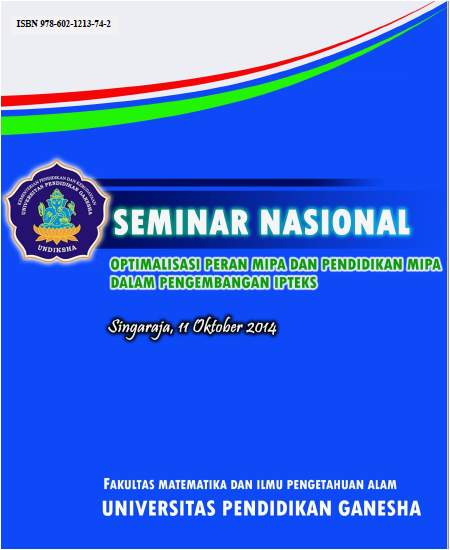ANALISIS POTENSI SEDIMEN HUTAN BAKAU SEBAGAI SUMBER ENERGI LISTRIK DENGAN MENGGUNAKAN TEKNOLOGI SEDIMENT MICROBIAL FUEL CELL (SMFC)
Abstract
Pemanfaatan bakteri untuk menghasilkan energi listrik merupakan upaya dalam mengembangkan sumber energi yang lebih efisien dan ramah lingkungan. Sediment Microbial Fuel Cell bekerja dengan memanfaatkan mikroorgnisme yang terdapat pada sedimen untuk mendegradasi bahan organik dan menghasilkan elektron yang ditransfer ke anoda kemudian dialirkan ke katoda. Penelitian ini adalah ekperimental yang bertujuan untuk membandingkan produksi kuat arus listrik yang dihasilkan oleh sedimen hutan bakau, dan menentukan efektivitas listrik yang dihasilkan oleh sedimen hutan bakau dan pengaruh dari pH, konduktivitas, dan salinitas air terhadap produksi kuat arus listrik, serta mengidentifikasi bakteri yang terdapat pada SMFC. Pelaksanaan kegiatan ini dilaksanakan selama 5 bulan dari bulan Maret s.d. Juli 2013. Pengambilan sampel dilakukan di Pamelisan Sesetan, Denpasar Selatan dan di Karang Sewu dan Teluk Terima, Taman Nasional Bali Barat. Kegiatan penelitian dilaksanakan di Laboratorium Ekologi dan Laboratorium Mikrobiologi, Jurusan Pendidikan Biologi, Universitas Pendidikan Ganesha Singaraja. Berdasarkan hasil penelitian dapat disimpulkan yaitu: (1) terdapat perbedaan rapat arus yang signifikan dari sampel sedimen, namun perbedaan tersebut disebabkan oleh sampel 2, untuk sampel 1, 3 dan 4 tidak memiliki perbedaan yang signifikan, (2) berdasarkan pendekatan teori, salinitas, suhu, pH, dan konduktivitas sebanding dengan rapat arus, dan (3) Hasil identifikasi bakteri diperoleh 5 isolat dengan hasil isolat A yaitu Aeromonas salmonicida, isolat B yaitu Pseudomonas sp., isolat yaitu C Vibrio gazogenes, isolat D yaitu Photobacterium lipolyticum, dan isolat E yaitu Salinivibrio siamensis.
Kata-kata kunci : Sediment Microbial Fuel Cell (SMFC), hutan bakau, listrik
Abstract: Exploiting bacteria to generate electrical energy in an effort to develop a more efficient energy sources and green energy. Sediment Microbial Fuel Cell works by utilizing microorganism contained in the sediments to degrade organic matter and produce electrons transferred to the anode then flowed to the cathode. This study was aimed to compare the experimental production of a strong electric current by mangrove sediments, and determine the effectiveness of the power produced by the mangrove sediments and the influence of pH, conductivity, and salinity of the water against the strong production of electric current, and identify the bacteria contained the SMFC. Implementation of these activities carried out for 5 months from March till July 2013. Sampling was conducted in Pamelisan Sesetan, South Denpasar and in Karang Sewu and Teluk Terima, West Bali National Park. Research activities carried out at the Ecology Laboratory and Microbiology Laboratory, Biology Education Department, Ganesha University of Education, Singaraja. Based on the results of this study concluded that : (1) there is a significant difference in the current density of the sediment samples, but these differences were caused by 2 samples, for samples 1, 3 and 4 do not have significant differences, (2) based on theoretical approaches, salinity, temperature, pH, and conductivity is proportional to current density, and (3) the identification of bacterial isolates obtained 5 with the result that isolates A is Aeromonas salmonicida, isolates B is Pseudomonas sp., isolates C is Vibrio gazogenes, isolates D is Photobacterium lipolyticum and isolates E is Salinivibrio siamensis .
Keywords: Sediment Microbial Fuel Cell ( SMFC ), mangrove forests, electricity
